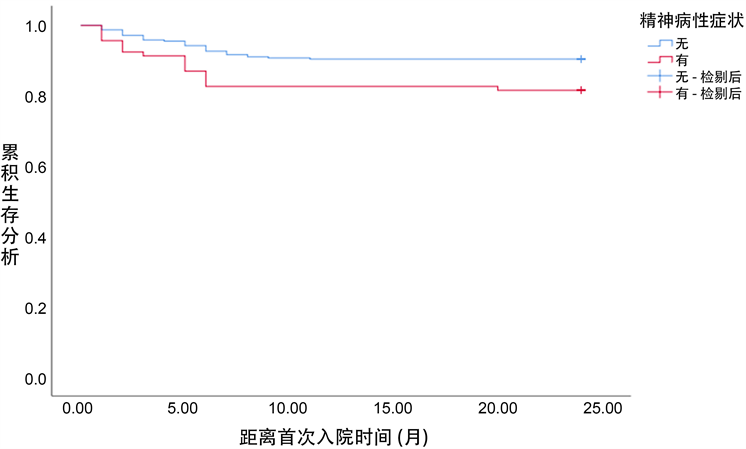摘要: 目的:探讨影响抑郁症(major depressive disorder, MDD)患者再入院的危险因素。方法:本研究采用回顾性调查的方法,利用电子病历系统(hospital information system, HIS)收集青岛市精神卫生中心2019年1月1日至2019年5月31日首次住院的MDD患者的住院病历信息,以此来探索MDD患者再入院的危险因素。结果:研究共纳入电子病历404份。多因素Logistic回归分析结果显示,精神病性症状、消极观念、白蛋白可能是首次住院的MDD患者发生再入院的独立影响因素。以上三个因素的受试者工作特征曲线(receiver operating characteristic curve, ROC)显示,精神病性症状曲线下面积(area under curve, AUC)为0.576,消极观念AUC为0.579,白蛋白AUC为0.548,三者组合以后,AUC升高为0.655。此外,伴或不伴有精神病性症状、伴或不伴有消极观念、白蛋白指标正常与否的两组间生存时间比较均有统计学差异。结论:伴有精神病性症状、伴有消极观念、白蛋白指标异常促进了首次住院MDD患者再入院的发生。这一结论可能会为MDD患者的治疗与预防提供新的方向。
Abstract:
Objective: The study aimed to investigate the risk factors of readmission for major depressive dis-order (MDD) patients. Methods: The risk factors for readmission of MDD patients were explored by retrospective investigation using the Hospital Information System (HIS) to collect inpatient medical records of MDD patients admitted to Qingdao Mental Health Center for the first time between Janu-ary 1, 2019 and May 31, 2019. Results: The study included 404 records. Multivariate regression analysis showed that psychosis symptoms, negative attempts, and albumin may be independent factors of readmission in first hospitalized MDD patients, when other confounding factors are con-trolled. The receiver operating characteristic curve (ROC) for all three factors showed an area under curve (AUC) of 0.576 of psychosis symptoms, negative attempts AUC of 0.579, and an albumin AUC of 0.548, which, when combined, increased to 0.655. In addition, there was a significant difference in survival analysis between the two groups with or without psychosis symptoms, with or without negative attempts, and with or without normal albumin indicators. Conclusions: Psychosis symp-toms, negative attempts, and abnormal albumin markers contribute to readmission in first hospi-talized MDD patients. This finding may provide new directions for the treatment and prevention of MDD patients.
1. 背景
精神障碍作为全球健康负担的主要原因之一,一直深受人们关注。2019年的一项研究报告显示,抑郁症(major depressive disorder, MDD)是最具致残性的精神障碍之一,并且在造成全球负担的主要疾病原因排名中持续上升。1990年和2019年的调查显示抑郁障碍均位列于全球负担主要疾病原因的前25名,且2019年排名上升6位 [1]。而2019年后,新型冠状病毒的流行,导致了更多的心理健康问题。有研究显示,2020年全球大约新增了5320万MDD患者 [2]。MDD是一类以慢性、复发性为特征的疾病 [3]。既往研究发现,尽管有MDD患者在经过适当的治疗后症状得到了改善,但是大约一半的患者在初步改善后会再次出现抑郁症状,包括情绪低落的反复,及行为、认知等方面的变化 [4] [5] [6]。故而,探索MDD复发的危险因素对于MDD的预防与治疗至关重要。
多项研究表明,多种危险因素共同影响MDD患者的复发 [7] [8] [9] [10]。既往有研究发现,年龄、性别等人口统计学变量与MDD患者的复发显著相关;也有研究发现如住院时长、临床症状等临床因素与MDD患者的复发显著相关,此外还有研究发现,血液指标与MDD患者的复发显著相关。然而,将人口统计学、临床特征、血液指标(非酶类抗氧化物、血脂、甲功)等各项因素均纳入的研究却很少 [11] [12] [13]。因此,在之后的研究中探索包括人口统计学、临床特征、血液指标等全部因素与MDD复发的相关性对于制定针对性的预防和干预策略十分必要。
在临床上,疾病的性质、个人因素、环境因素、不完全治疗等均可通过再入院的概率有所反映 [3]。再入院被认为是MDD患者复发的直接客观结果 [10]。本研究旨在通过病例回顾分析,探讨青岛市精神卫生中心MDD患者再入院的危险因素,为复发的早期识别、及时干预和正确诊治提供科学的临床依据。
2. 方法
2.1. 研究对象
选取2019年1月1日至2019年5月31日于青岛市精神卫生中心首次住院的、符合诊断标准的MDD患者。纳入标准为:① 出院诊断为符合国际疾病与分类诊断标准第10版(ICD-10)中的抑郁症诊断标准,即编码为F32~F33;② 本次为首次住院(即在2019年以前未查及住院经历),住院病历清晰、完整;③ 性别不限。排除标准为:① 诊断为MDD之外的其余精神科疾病;② 18岁以下;③ 怀孕妇女或哺乳期;④ 入院前6个月内曾行电休克治疗。
2.2. 数据来源
本研究采用回顾性调查方法,利用电子病历系统(HIS)收集青岛市精神卫生中心2019年1月1日至2019年5月31日首次住院的MDD患者的住院病历信息。一切研究资料在电子病历系统中均可查询,以确保这些研究资料的真实可靠。已经隐藏所有研究资料中研究对象的个人敏感信息,研究未涉及任何伦理问题。
根据研究目的设计自制临床资料收集表,所收集信息主要包括:一般人口统计学特征,住院时长、病程、发病年龄、临床症状特征、有无躯体疾病、入院前用药情况、甲状腺功能(Triiodothyronine, T3, Thyroxine, T4, Free Triiodothyronine, FT3, Free thyroxine, FT4, Thyroid Stimulating Hormone, TSH)、生化(尿酸、白蛋白、胆红素等非酶类氧化应激指标以及血脂指标)等化验结果及再入院信息。血液来源为患者入院后次日晨起抽取的空腹血,各项血液指标由获得资格的检验科医师统一测量。再入院信息包括再入院诊断、再入院时间。因为大多数再入院发生在首次入院后2年内 [10] [14],所以本研究中的再入院限制为HIS中可查及的两年内再次入院的记录(即再入院时间最晚不超过2021年5月31日)。
2.3. 统计学
使用IBM SPSS Statistics 25软件进行统计分析。所有统计检验均采用双侧检验,计量资料组间比较通过正态性检验后,根据数据分布特征使用参数或非参数检验,分类资料组间比较使用χ2检验/Fisher确切概率检验,对各因素进行单因素logistic回归,将单因素logistic回归分析结果中(P < 0.2)的因素全部纳入在多因素Logistic回归分析中,筛选出与MDD患者再入院相关的危险因素(P < 0.05为差异有显著性)。将多因素回归分析后有显著差异的因素通过GraphPad Prism 8绘制受试者工作特征曲线(receiver operating characteristic curve, ROC)。同时采用Kaplan-Meier (KM)法进行生存分析,并通过Log Rank检验。
3. 结果
研究共纳入电子病历404份。其中2年内再入院且未更改诊断的患者病历47份,未再入院的患者病历357份。具体结果如下:① 通过首次住院的MDD患者再入院组与未再入院组两组间差异性分析可知,年龄、入院前已服用精神科药物、精神病性症状、消极观念、总胆红素、白蛋白等因素在两组间存在显著性差异(P < 0.05) (见表1);② 对表1中各因素与首次住院MDD患者再入院的发生进行单因素logistic回归(见表2)可知,在未控制混杂因素时,入院前已服用精神科药物、精神病性症状、消极观念、总胆红素、白蛋白等因素与首次住院MDD患者再入院的发生具有相关性(P < 0.05);③ 多因素回归分析纳入的因素包括表2中P < 0.2的所有因素,由此可知,在控制其他混杂因素的前提下,精神病性症状(B = 0.928, Wald = 6.474, P = 0.011, OR = 2.530)、消极观念(B = 0.700, Wald = 4.185, P = 0.041, OR = 2.013)、白蛋白(B = 2.045, Wald = 6.119, P = 0.013, OR = 7.733)可能是首次住院的MDD患者发生再入院的独立影响因素(见表3);④ ROC曲线示,多变量回归分析中P < 0.05的各因素结果如下:伴或不伴有精神病性症状AUC值为0.576、伴或不伴有消极观念AUC值为0.579、白蛋白指标正常与否AUC值为0.548,将以上因素结合起来时,可以获得较高的AUC值,即0.655 (见图1)。⑤ 伴或不伴有精神病性症状、伴或不伴有消极观念、白蛋白指标正常与否的两组间生存时间比较均有统计学差异。各组平均生存时间如下:不伴有精神病性症状组的平均生存时间为22.131个月,而伴有精神病性症状组的平均生存时间为20.402个月(P = 0.017),不伴有消极观念组的平均生存时间为22.236个月,而伴有消极观念组的平均生存时间为20.893个月(P = 0.037),白蛋白指标正常组的平均生存时间为21.934个月,而白蛋白指标异常组平均生存时间为13.111个月(P < 0.001) (见图2)。

Table 1. Demographics, clinical characteristics, and blood markers between the readmission and non-readmission groups of first hospitalized patients with Major Depressive Disorder (MDD)
表1. 首次住院的MDD患者再入院组与未再入院组两组间人口统计学、临床特征、血液指标方面的比较
注:*为费希尔精确检验法。T3,三碘甲状腺原氨酸;T4,甲状腺素;FT3,游离三碘甲状腺素;FT4,游离甲状腺素;TSH,促甲状腺激素。

Table 2. Univariate Logistic regression results for readmission among MDD patients
表2. MDD患者再入院单因素Logistic回归结果
注:T3,三碘甲状腺原氨酸;T4,甲状腺素;FT3,游离三碘甲状腺素;FT4,游离甲状腺素;TSH,促甲状腺激素。

Table 3. Multivariate Logistic regression results for readmission among MDD patients
表3. MDD患者再入院多因素Logistic回归结果
注:FT4指游离甲状腺素。纳入的因素为表2单因素logistic回归中P < 0.2的全部因素。

Figure 1. Factors distinguish readmissions from non-readmission in MDD patients who are admitted to hospital for the first time
图1. 相关因素对首次住院的MDD患者发生再入院与未发生再入院的区分能力
 (A)
(A)  (B)
(B)  (C)
(C)
Figure 2. (A) Intergroup survival analysis with or without psychotic symptoms; (B) Intergroup survival analysis with or without negative attempts; (C) Intergroup survival analysis with or without normal albumin indicators
图2. (A) 为伴或不伴有精神病性症状组间生存分析;(B) 为伴或不伴有消极观念组间生存分析;(C) 为白蛋白正常与异常组间生存分析
4. 讨论
这是一项回顾性研究,主要探索了首次住院的MDD患者再入院的相关危险因素。主要结论是:精神病性症状、消极观念、白蛋白三个因素可能是MDD患者再入院的危险因素。具体来说:① 入院时伴有精神病性症状、伴有消极观念、白蛋白指标异常促进了首次住院的MDD患者再入院的发生;② 精神病性症状、消极观念、白蛋白三个因素分别预测首次住院MDD患者再入院发生的能力均较弱,三者组合后,预测能力提升;③ 生存分析显示,精神病性症状、消极观念、白蛋白三个因素显著影响了首次住院的MDD患者2年内累积生存率。
既往研究发现,年龄、住院时长、共病躯体疾病、甲状腺功能等因素与MDD患者再入院相关 [3] [15] [16] [17] [18]。但是本研究中,经过多因素回归分析后,并未发现以上因素与MDD患者再入院有相关性。既往研究与本研究结果存在不一致,可能与既往研究多为针对精神科多个疾病的总体研究而不是仅仅针对首次住院的MDD患者有关。另外,也可能与本研究样本量不足有关,后续研究可增加样本量进一步探索。
Hardeveld等人的研究提到,临床症状的残留可能是MDD患者复发最重要的预测因子 [13]。对于大多数MDD患者来说,较为严重的临床症状在出院时常有残留,Kennedy进行的一项研究中报道,出院时伴有残留症状的受试者2年内会更容易出现复发 [19]。Jang等人发现,自杀意念是MDD复发显著的预测因素 [20]。本研究中,同样发现,部分易残留的临床症状如精神病性症状、消极观念等与再入院显著相关。本研究结果显示,伴有精神病性症状、伴有消极观念促进了首次住院MDD患者再入院的发生。
而关于可能影响MDD复发的血液标志物众说纷纭。其中,有研究表明,多种生物学过程和途径参与了MDD的发生发展,其中提到了氧化应激 [21] [22]。研究指出,氧化–抗氧化失衡可能是氧化应激参与MDD发生的具体机制 [21] [23]。既往已经有研究报道,MDD患者白蛋白水平低可能预示复发 [24]。而另外一项meta分析表示,抑郁症患者血清抗氧化水平显著降低,其中包括白蛋白 [25]。2022年一项双向孟德尔随机化研究指出,MDD患者与胆红素下降相关 [26]。这与本研究结果部分一致。一方面,本研究结果显示,白蛋白指标异常促进了MDD患者再入院的发生。另一方面,本研究显示,在控制混杂因素后,总胆红素与MDD患者并无相关性。这可能是因为与既往研究采用的研究方法及纳入的变量不一致而出现的。
当然本研究有一些局限性。首先,本研究为回顾性研究,所得结果并未通过前瞻性队列研究来证实。其次,本研究只关注了指标的异常与否,但未关注指标是降低还是升高,故而只能得出指标异常(未明确降低或升高)与MDD再入院的相关性。另外,鉴于尚无针对电子病历中症状严重程度的明确分级标准,本文研究的都是较为典型的临床症状的有无,并未对有症状的患者进行严重程度分级。最后,本研究为只涉及了一家医院患者的单中心研究,后续可以纳入多中心的病人进行进一步研究。
本文初步探索了首次住院的MDD患者再入院的危险因素,虽然证据仍然有限,但这项研究为进一步深入探索住院后再入院预测因素提供了可能。而且这一结论可能会为MDD患者的治疗与预防提供新的方向。但是为更好地预测MDD患者首次住院后的预后状况,需要后续研究中优化研究方案,增加样本量,多中心构建预测模型,为预防复发和降低MDD患者再入院率提供进一步支持。
基金项目
山东省医药卫生科技发展计划项目立项计划(2017ws748)。
NOTES
*通讯作者。